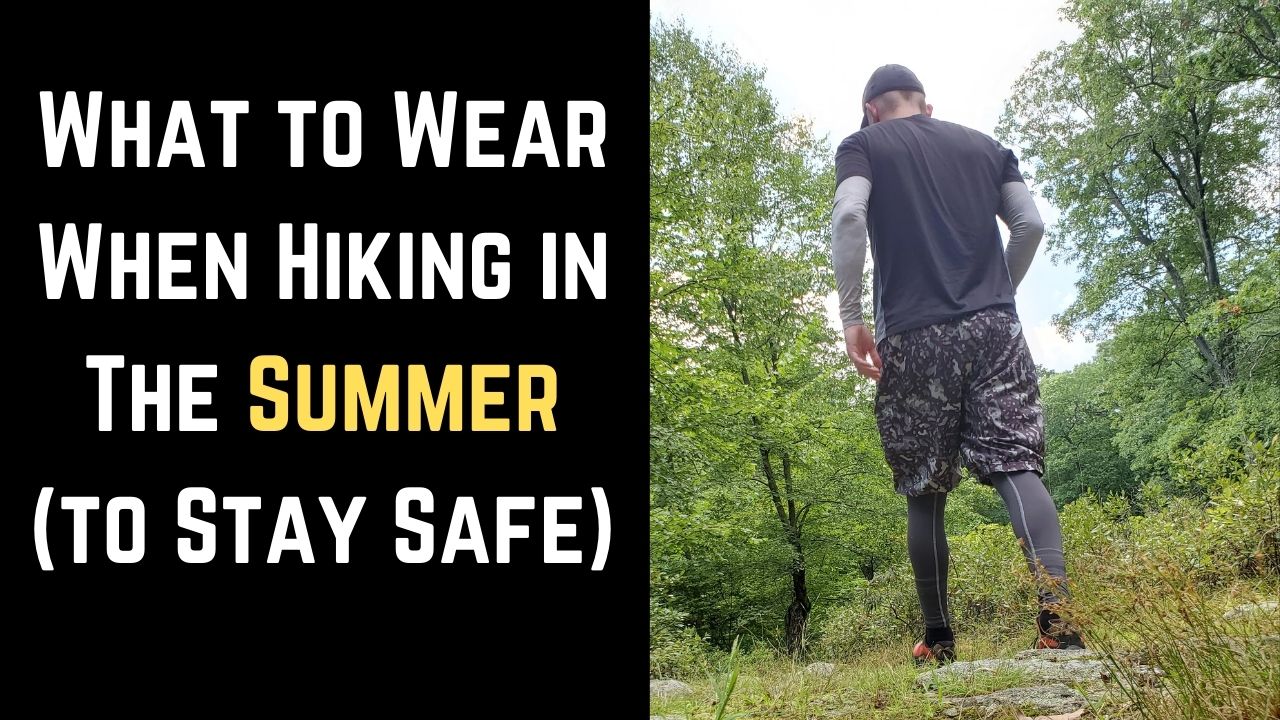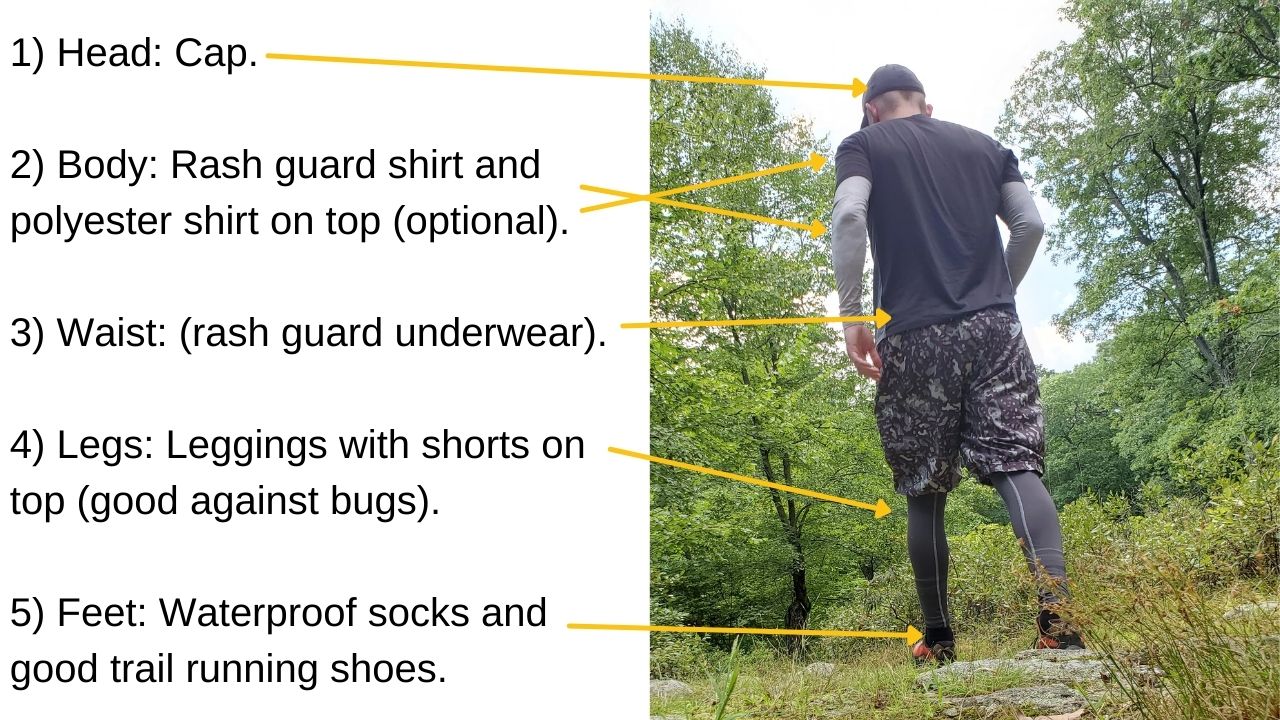What to Wear When Hiking in The Summer to Stay Cool

I have personally found knowing what to wear when hiking in the summer is critical to your safety in more ways than one and in this post, I’d like to share exactly how I tackle this subject.
First, let me just say that in my personal experience, hiking in the summer carries more dangers than when hiking in the winter. Here’s just a few of those risks:
- You sweat and dehydrate easier (more cramps, passing out risk).
- You can get a sunstroke easier (or sunburns).
- Animals (like bears) are usually more active in the summer.
- You generally have to carry more stuff (like water and food) in order to stay hydrated and full.
This is why I prefer hiking during cold periods vs warm and hot ones. But sometimes a hike can’t wait for the right (cold) occasion which is why if the opportunity to go hiking in the summer comes up, you should take it. Just make sure you are properly dressed for it. And that seque’s into the main topic:
Here’s what you need to wear when hiking in the summer:

Let’s cover the different parts of the body (from top to bottom):
- Head: Cap is usually fine.
- Body: I like wearing a rash guard shirt or t shirt (mostly polyester).
- Waist: Rashguard underwear.
- Legs: Leggings with shorts over them or regular sports pants (I wear under armor).
- Feet: I always wear waterproof socks and trail running shoes.
I’ve had this kind of outfit in hikes when it’s nearly 100 degrees outside.
Now in addition to that, I also like to bring an extra shirt (for a 10 mile run) and have a second shirt to change into when I reach my car (finishing the hike).
Now here’s the thing, bringing the right supplies on a hike (especially in the summer) is even more important than what you wear, so here’s a list of things I bring:
- 3 liter hydration pack (for 10 miles).
- 1-2 bottles of a hydration drink with pH flour salts (or Gatorade).
- 2-3 energy bars for a 10 mile hike.
- Bear spray.
- Compass.
- Soap when I change shirts (I can’t stand running out sweaty in the summer for too long).
Details of why I wear what I wear on my summer hikes:

1) Head: Cap.
In case you didn’t know, I’m pretty bald and running around in the summer, under the sun for too long is very dangerous for me. In fact, even if you have a head full of hair, it’s never a good idea to run with the sun shining over your head for too long.
A cap protects your head from the rays and while yes, your head will get hot overtime, you can easily remove the cap when running past a stream and douse yourself with cold water to cool off. When you get to places in your hike where there’s shade, you can certainly take off your cap there.
2) Body: Why I like wearing a rash guard shirt (or polyester shirt):
I generally do not like sweating too much and a rash guard shirt is great at absorbing it. In addition, rash guard shirts also compress my muscles so there’s less chances of aches, especially when I do long hikes. And just as well, rash guard shirts are very comfortable to wear in any weather environment (I love wearing them when I hike in the rain too or in the winter time).
Now I also do wear a polyester shirt, but I’ll typically use that a secondary shirt when I change mid way into my hikes. A cotton shirt feels like an oven when worn in the summer, but a polyester one feels great even when you’re sweating (it’s also good against bugs).
3) Waist: Rash guard underwear.
“That” part of your body is going to sweat a lot and it’s also in the most enclosed area of your body anyway. To me, wearing a rash guard underwear is usually very comfortable and it prevents a lot of rashes from wearing normal underwear.
4) Legs: Rash guard leggings with shorts over it and/or under armor pants.
If it looks like it’s going to be a very hot summer hike, I’ll usually wear the first option and if I know I’m going to be in areas with a lot of shade and finish my hike when it gets colder, I’ll likely wear the second option.
I prefer to wear one of these 2 options for a few reasons:
- First, it’s comfortable and I can run pretty comfortably with it.
- Second, it protects me from bugs, possibly tick bites and gives me less chances of scraping against sharp rocks or poison ivy plants. I will never understand how people can walk around with a lot of skin showing on a hike. Even if you look great and bring bug spray, it’s still a dumb idea because you put yourself in unnecessary danger. Bugs are everywhere when you go hiking (some could be poisonous), especially in the summer so wear at least leggings to protect your skin.
Now for the legs, I generally do not bring a second layer of clothing like I do for my shirt (you can if you have the space in your backpack). There is one other optional thing you can wear and that’s jeans for hiking in the summer, but I would only do that if you have no better options like leggings or rash guards.
5) Feet: Waterproof socks and also trail running sneakers.
I always go for this no matter what kind of hike I do. Waterproof socks are excellent for summer hikes as they help you get through muddy and wet areas without actually getting wet and then having problems arise and trail running shoes are always a good idea for hiking in general (I wear Salomon Speedcross sneakers).
Do not neglect the necessary supplies for a summer hike folks!
I mentioned them above, but I cannot stress how important they are. Water is your top item to bring on a summer hike, but do not make the mistake of having that be your only liquid. Bring some salt pills, an extra bottle of Gatorade and/or pH flour salts because if you just bring water, drink it over and over, sweat it out and continue repeating that, you’re going to get cramps and really screw yourself (and may even need to be bailed out by park Rangers).
To carry all of my supplies, I’ll generally bring one main backpack which is my Outdoors Products Hydration Pack. It’s small, but generally can carry everything I need for my summer hikes, including my extra clothing. Now if you’re advanced and know how to regulate your supplies, you may even “upgrade” to a hydration vest like the Salomon ADV Hydra Vest 4 but I would stick to the first option as it holds more.
I’ve run on many summer hikes and I promise you that this clothing will suffice in more ways than you know!
